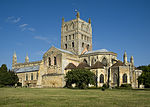Eleanor de Clare

Eleanor de Clare, suo jure 6th Lady of Glamorgan (3 October 1292 – 30 June 1337) was a powerful Anglo-Welsh noblewoman who married Hugh Despenser the Younger, the future favourite of Edward II of England, and was a granddaughter of Edward I of England. With her sisters, Elizabeth de Clare and Margaret de Clare, she inherited her father's estates after the death of her brother, Gilbert de Clare, 8th Earl of Gloucester, 7th Earl of Hereford at the Battle of Bannockburn in 1314. She was born in 1292 at Caerphilly Castle in Glamorgan, Wales and was the eldest daughter of Gilbert de Clare, 6th Earl of Hertford, 7th Earl of Gloucester, 5th Lord of Glamorgan and Princess Joan of Acre.
Excerpt from the Wikipedia article Eleanor de Clare (License: CC BY-SA 3.0, Authors, Images).Eleanor de Clare
Church Street,
Geographical coordinates (GPS) Address Nearby Places Show on map
Geographical coordinates (GPS)
| Latitude | Longitude |
|---|---|
| N 51.9903 ° | E -2.1604 ° |
Address
Tewkesbury Abbey
Church Street
GL20 5SA , Priors Park
England, United Kingdom
Open on Google Maps










